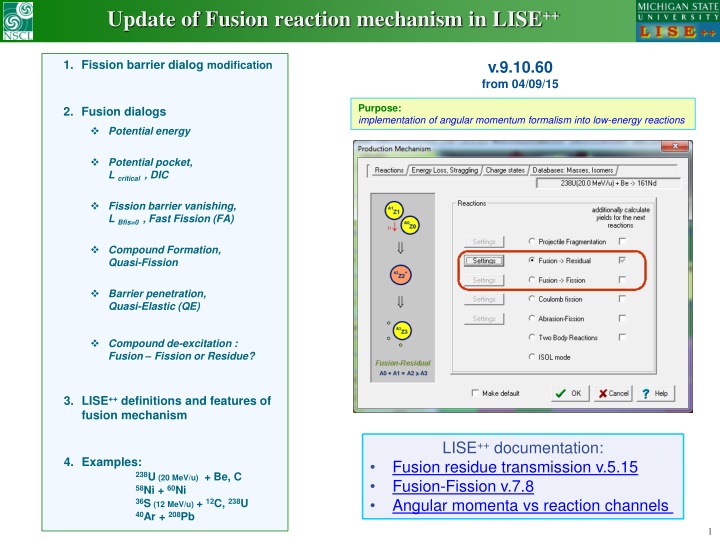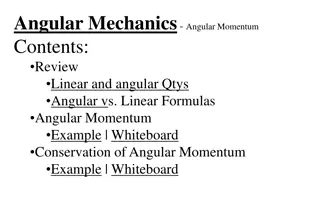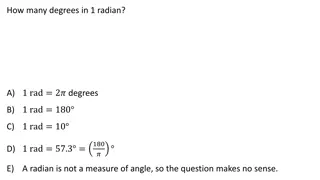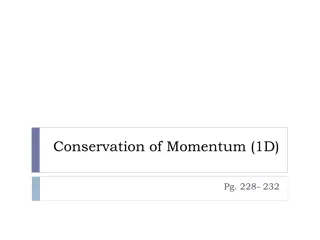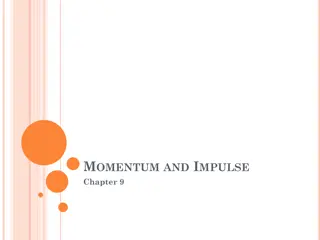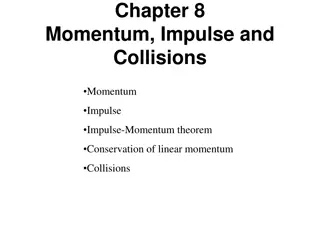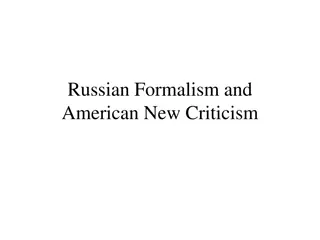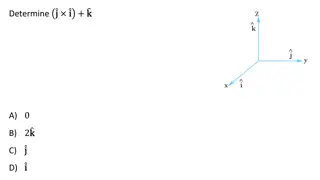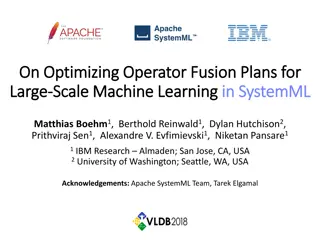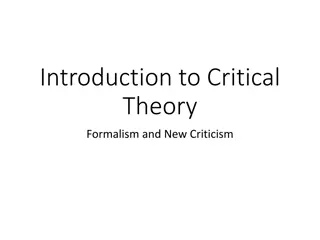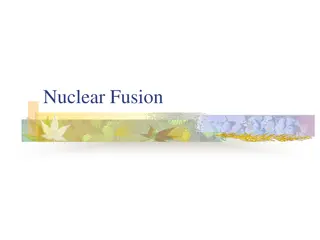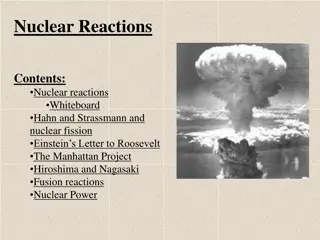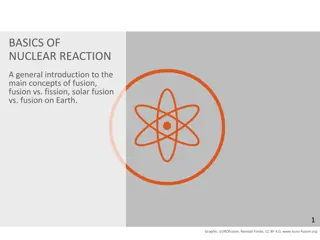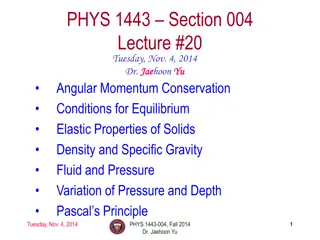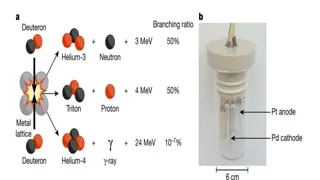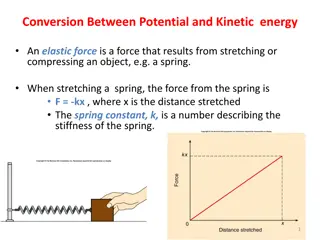Implementation of Angular Momentum Formalism in Low-Energy Fusion Reactions
This update focuses on integrating the angular momentum formalism into low-energy fusion reactions using the LISE++ platform. It explores fission barriers, potential energy pockets, compound formation, and de-excitation processes in fusion reactions. The documentation delves into fusion residue transmission, fusion-fission mechanisms, and the role of angular momenta in reaction channels. Examples using various projectiles and targets are provided, highlighting the importance of fission barrier modifications for understanding fusion-fission or residue outcomes. The significance of barrier factors in describing experimental data and sophisticated calculations is also discussed, emphasizing the crucial role of fission barriers in the competition between particle evaporation and fission during the de-excitation process.
Download Presentation

Please find below an Image/Link to download the presentation.
The content on the website is provided AS IS for your information and personal use only. It may not be sold, licensed, or shared on other websites without obtaining consent from the author.If you encounter any issues during the download, it is possible that the publisher has removed the file from their server.
You are allowed to download the files provided on this website for personal or commercial use, subject to the condition that they are used lawfully. All files are the property of their respective owners.
The content on the website is provided AS IS for your information and personal use only. It may not be sold, licensed, or shared on other websites without obtaining consent from the author.
E N D
Presentation Transcript
Update of Fusion reaction mechanism in LISE++ 1. Fission barrier dialog modification v.9.10.60 from 04/09/15 Purpose: implementation of angular momentum formalism into low-energy reactions 2. Fusion dialogs Potential energy Potential pocket, L critical , DIC Fission barrier vanishing, L Bfis=0 , Fast Fission (FA) Compound Formation, Quasi-Fission Barrier penetration, Quasi-Elastic (QE) Compound de-excitation : Fusion Fission or Residue? 3. LISE++ definitions and features of fusion mechanism LISE++ documentation: Fusion residue transmission v.5.15 Fusion-Fission v.7.8 Angular momenta vs reaction channels 4. Examples: 238U (20 MeV/u) + Be, C 58Ni + 60Ni 36S (12 MeV/u) + 12C, 238U 40Ar + 208Pb 1
Fission barrier dialog modification 1. Fission barrier and Yrast line plots as function of L 2. New Fission barriers from P.Moller et al., PRC91(2015)024310 3. BarFac parameter for the SHE region 4. Sierk s fission barrier validity 2 O.Tarasov, 10-Apr-2015, East Lansing
Fission barrier dialog modification 1. Fission barrier and Yrast line plots as function of L 2. New Fission barriers from P.Moller et al., PRC91(2015)024310 3. BarFac parameter for the SHE region 4. Sierk s fission barrier validity It looks like a high Barrier value with AME2012 use. But LISE++ allows to load an user mass excess table 3 O.Tarasov, 10-Apr-2015, East Lansing
Fission barrier dialog modification 1. Fission barrier and Yrast line plots as function of L 2. New Fission barriers from P.Moller et al., PRC91(2015)024310 3. BarFac parameter for the SHE region 4. Sierk s fission barrier validity Barrier factor to describe experimental data or sophisticated calculations Fission barrier value plays crucial role between particle evaporation and fission competition in de-excitation process 4 O.Tarasov, 10-Apr-2015, East Lansing
Fission barrier dialog modification 0. Sierk s fission barrier is operating up to Z 110 @ L=0 or Z 102 @ L>0 1. Fission barrier and Yrast line plots as function of L 2. New Fission barriers from P.Moller et al., PRC91(2015)024310 1. So, if Sierck s fission barrier has been selected , and nucleus atomic number is higher 110 at L=0, than Cohen s barrier will be used. 3. BarFac parameter for the SHE region 4. Sierk s fission barrier validity 2. If if Sierck s fission barrier has been selected , and nucleus atomic number is higher 102 at L>0, then vanishing factor for Z=102 (with the same N/Z ratio) will be used, where the Vanishing factor (L) is the ratio of Barrier(A,Z,L) / Barrier(A,Z,0) Vanishing barrier factor for data from FILEs is based on selection from Sierk or Cohen models in the Fusion dialog 5 O.Tarasov, 10-Apr-2015, East Lansing
Fusion-Residue and Fusion-Fission dialogs in LISE++ Do not hesitate to use Low-Energy reaction computing centers as NRV for more sophisticated solutions with Channel Coupling, Langevin equations and so on 6 O.Tarasov, 10-Apr-2015, East Lansing
Coming back to the Eighties for definitions 7 O.Tarasov, 10-Apr-2015, East Lansing
Potential Energy Default NRV parameters 8 O.Tarasov, 10-Apr-2015, East Lansing
Critical momentum Critical momentum : L-value corresponds to potential energy when the pocket is washed out. No fusion Deep Inelastic Collision region Lcritical L < Ldirect Lcritical The potential pocket does not exists, and the EnergyCM is above the barrier 9 O.Tarasov, 10-Apr-2015, East Lansing
Deep Inelastic Collision region Deep Inelastic Collision region Lcritical L < Ldirect The potential pocket does not exists, and the EnergyCM is above the barrier 10 O.Tarasov, 10-Apr-2015, East Lansing
Fission Barrier Vanishing as f(L) Fast Fission (FA) Fast Fission region LBfis=0 L < Lcritical The potential pocket still exists, but no compound formation 11 O.Tarasov, 10-Apr-2015, East Lansing
Compound formation, Quasi-Fission : 48Ca + 208Pb 12 O.Tarasov, 10-Apr-2015, East Lansing
Compound formation, Quasi-Fission : 58Fe + 208Pb 13 O.Tarasov, 10-Apr-2015, East Lansing
Barrier penetration, Quasi-Elastic (QE) : 238U(5.4 MeV/u) + C Tl(E) denotes the transmission coefficient of the l-th partial wave through the barrier in the total potential 14 O.Tarasov, 10-Apr-2015, East Lansing
Barrier penetration, Quasi-Elastic (QE) : 238U(20.0 MeV/u) + C Tl(E) denotes the transmission coefficient of the l-th partial wave through the barrier in the total potential 15 O.Tarasov, 10-Apr-2015, East Lansing
Fusion Fission or Residue? 1st step compound de-excitation plot fission 16 O.Tarasov, 10-Apr-2015, East Lansing
LISE++ reaction interpretation from R & L 17 O.Tarasov, 10-Apr-2015, East Lansing
What cross sections will be used in LISE++ to get rates? LISE++ still uses the Bass formalism to calculate fragment rates !!!! You have to use this calculated factor later to take into account the analysis of partial cross sections 18 O.Tarasov, 10-Apr-2015, East Lansing
Fusion dialog warning message for barrier settings Go to the Fission barrier dialog to modify settings for this SHN region You will get this message if The compound Z > 95 In-built fission model (Barfit, FisRot, or LDM) was selected BarFac parameter < 1.2 19 O.Tarasov, 10-Apr-2015, East Lansing
238U (20.6 MeV/u) with Be vs. C targets Carbon target.. 50% split Why? This is due to difference of moments of inertia between C+U and Be+U just above where fission barrier go to zero 20 O.Tarasov, 10-Apr-2015, East Lansing
Fission channels for 238U (20 MeV/u) + Be,C reactions Partially go to fission Fissile Z~92 Low Excitation Energy Compound fission ~100% Fissile Z = 96 High Excitation Energy Sequential fission after DIC Fissile Z < 92 High Excitation Energy 21 O.Tarasov, 10-Apr-2015, East Lansing
Experimental study of barrier distributions for 58Ni+60Ni http://aip2014.org.au/cms/uploads/presentation/elizabeth_williams.pdf Dr. Elizabeth Williams Department of Nuclear Physics The Australian National University, Canberra, ACT, Australia AIP Congress, Canberra, ACT 9 December 2014 22 O.Tarasov, 10-Apr-2015, East Lansing
36S (12 MeV/u) + 12C, 238U 12C 238U 23 O.Tarasov, 10-Apr-2015, East Lansing
40Ar + 208Pb 24 O.Tarasov, 10-Apr-2015, East Lansing
Acknowledgements I would like to acknowledge to Profs. D.J.Morrissey, M.Thoennessenn, Z.Kohley (NSCL/MSU), Dr.G.Knyazheva (FLNR/Dubna), for fruitful discussions. 25 O.Tarasov, 10-Apr-2015, East Lansing
